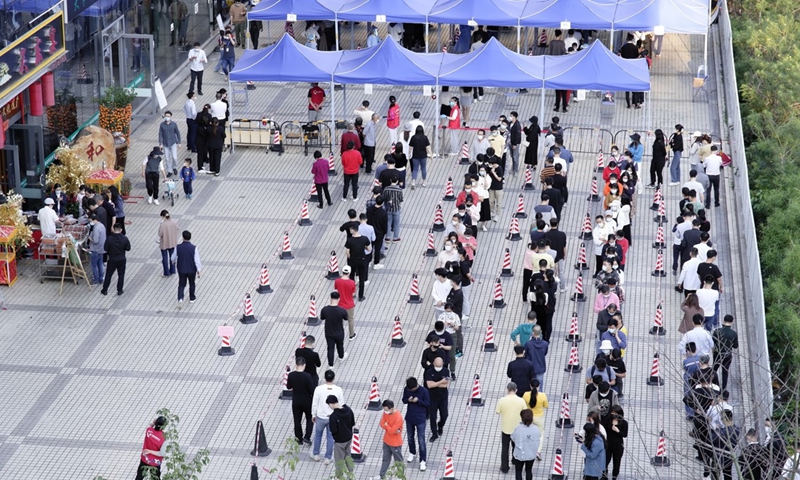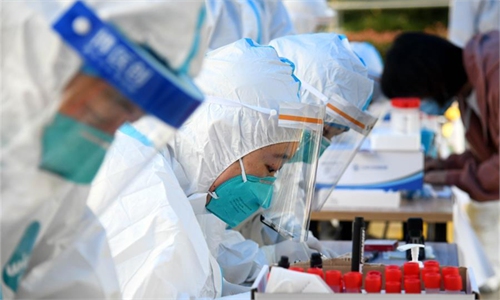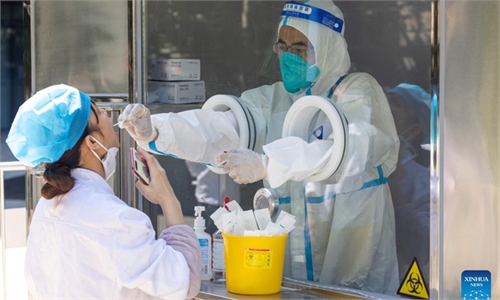‘Dynamic and scientific’: Shenzhen tightens regular testing request amid sporadic infections while epidemic-free cities slow down regular screening

Residents line up for free nucleic acid testing at the special Information Port in Shenzhen's Nanshan district, South China's Guangdong Province. Shenzhen reported 66 local infections on March 13, raising the tally of cases to 432. Photo: IC
After more than a month of clearance of infections in Shenzhen, South China's Guangdong Province, the city has reported sporadic local COVID-19 cases in recent days. In light of this, Shenzhen has tightened its anti-epidemic measures by requesting its residents to show negative nucleic acid testing results obtained within 48 hours or proof of testing records within 24 hours when using public transportation or entering public enclosed areas starting from Friday.
On Saturday, Shenzhen found two asymptomatic COVID-19 cases during routine community nucleic acid screening. On Monday, the city reported another two locally transmitted asymptomatic cases, which were detected among close contacts of the cases on Saturday. And on Wednesday, the city found three more locally transmitted asymptomatic cases, according to the Shenzhen Health Commission on Thursday.
The source of the infections remains unclear.
In order to quickly track down the spread of the epidemic, and cut the chain of transmission as soon as possible, Shenzhen carried out a round of citywide nucleic acid testing on Saturday, officials said.
Also, starting from Friday, the city has asked residents to show a negative certificate of a nucleic acid test within 48 hours or proof of a testing record within 24 hours when taking public transportation or entering public enclosed areas.
A test every two days is enough for people in key areas to detect infections, Lu Hongzhou, head of Shenzhen's anti-epidemic expert team and head of the Third People's Hospital of Shenzhen, told the Global Times on Thursday.
At present, most of the epidemic sources in China are imported, and people entering China, the cold chain and international logistics are high-risk factors, Lu said, noting that first-tier cities and port cities with special geographical locations like Shenzhen are at high risk of imported cases.
Wang Guangfa, a Beijing-based respiratory expert, told the Global Times that nucleic acid testing has been a key method to detect COVID-19 virus carriers, so as to control the source of transmission, one of the first steps in the dynamic zero-COVID strategy.
The pioneer of implementing regular nucleic acid testing was Shenzhen, which was affected by the fifth wave of the epidemic in the Hong Kong Special Administrative Region. At that time, Shenzhen stopped the epidemic in a week by suspending public transportation and requesting 48-hour negative nucleic acid certificates at breakneck speed.
In light of this new wave of sporadic local infections, Shenzhen is trying to use this method again to quickly get the situation under control.
A theoretical model established by epidemiologist Huang Senzhong of Nankai University has indicated the importance of the role of regular nucleic acid testing in early detection.
Compared with the previous pattern that an outbreak was exposed after symptomatic patients sought treatment, regular nucleic acid testing can bring down the time it takes to detect the first infected case from 7-10 days to four days, thus reducing the infection scale by three to four times, according to Health Insight, a Chinese media outlet.
Multiple cities across China have adjusted their nucleic acid testing cycles in light of the overall improvement of the situation. Some cities extended the regular testing period from three days to five, while other ended the regular testing request.
Starting from Wednesday, residents entering communities, schools, work units and other public places in Wuhan, Central China's Hubei Province are required to provide negative nucleic acid test results obtained within five days. Previously, the city requested once-in-three-day testing.
Hefei, Lu'an and Huainan in East China's Anhui Province, has suspended regular nucleic acid testing starting from Wednesday.
Cinemas in Dezhou, East China's Shandong Province no longer require 48-hour negative testing results. Travelers in Huizhou, South China's Guangdong Province are no longer requested to hold 48-hour negative test certificates.
Also, a number of hospitals in Shanghai have eased their nucleic acid testing request for patients and their family members.
As experience is drawn on from previous outbreaks, local governments have grasped the handling of COVID-19 and they now use more targeted, science-based methods in the process of achieving dynamic zero-COVID, Wang said.
The regular testing fever cooled down less than two months after the construction of 15-minute circles of nucleic acid testing services in big cities began in early May.
"Whether to build such services needs to be evaluated based on local epidemic risks, population size, the frequency of nucleic acid testing and other factors. Blindly following the trend is more of an unnecessary waste of resources," said Lu.
Imposing regular nucleic acid testing in non-epidemic areas is done to monitor potential COVID-19 transmission, which is necessary and important, as now the prevalent Omicron strain is stealthy and difficult to find, due to having mild or no symptoms, Wang noted.
The scope and frequency of regular tests for this variant should also be varied based on the levels of COVID-19 risks that each population group or region is facing, the expert added.





